Kenneth L. Gentry Jr.'s Blog, page 94
November 9, 2016
THOSE WHO DWELL ON THE EARTH (4)
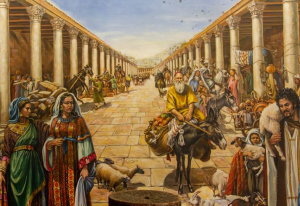 PMT 2016-082 by Kenneth L. Gentry, Jr.
PMT 2016-082 by Kenneth L. Gentry, Jr.
This is the fourth and final article in a series exploring the meaning of “those who dwell on the earth” in Revelation. I am arguing that “earth” should be translated “Land” (i.e., of Israel), and that the phrase refers to the Jews in Israel. So let’s continue!
We find the second clear reference in our text in 6:10. Here we read: “They cried out with a loud voice, saying, ‘How long, O Lord, holy and true, will You refrain from judging and avenging our blood on those who dwell on the earth [tōn katoikountōn epi tēs gēs]?’” (6:10). That the Land-dweller phrase clearly applies to Jews in Israel appears on the following evidence.
(1) In the NT the only other phraseology outside of Rev that is similar to this appears in Lk 21:35 which bears “striking similarities” (Penley 90; cp. 105ff) to Rev 6:10 and which applies to Israel in AD 70. There we read of judgment that will suddenly come: “for it will come upon all those who dwell on the face of all the earth.” As I argue in the Introduction to this commentary, John’s drama is a revelation from Jesus Christ (1:1) and draws frequently from Jesus’ teaching. In fact, the seals specifically follow the pattern of his Olivet Discourse and Lk 21:35 appears in Luke’s version of that Discourse. There in Luke the phrase is expanded: epi pantas tous kathēmenous epi prosōpon pasēs tēs gēs. The major translations give a universalistic reading along the lines of the NASB: “all those who dwell on the face of all the earth.” The translators are mistaken, for Luke 21 is dealing with God’s judgment on Israel. As evidence I would offer the following:
Four Views on the Book of Revelation
(ed. by Marvin Pate)
Helpful presentation of four approaches to Revelation. Ken Gentry writes the chapter on the preterist approach to Revelation, which provides a 50 page survey of Revelation .
See more study materials at: www.KennethGentry.com
(a) The Lord’s eschatological discourse arises from his announcing the temple’s approaching doom (Lk 21:5–6). (b) He expressly warns his disciples of the desolation coming upon Jerusalem (v 20), the need to flee from Judea (v 21), and the Gentile trampling of the holy city (v 24). © Within this five verse section (Lk 21:20–24) — which clearly emphasizes Jerusalem’s destruction — appears his first mention of “the land” and its people: “there will be great distress upon the land, and wrath to this people” (anagkē megalē eip tēs hēs kai orgē tō laō toutō). Most commentators recognize this as referring to Israel. Thus, what we have here is “Luke’s first use of tēs gēs in the eschatological discourse sets a precedent that is taken up again in Lk. 21.35” (Penley 100). (d) Immediately after Jerusalem’s destruction (vv 20–24) Jesus mentions cosmic signs that cause dismay among the nations, which is language that is applied to Israel’s judgment in the OT. We see this in Jer 4:27–28 (=Israel, vv 14, 16, 20, 22) and Joel 2:10 (=Israel, vv 1 [hoi katoikountes tēn gēn], 12–13, 15–18). Thus, in these OT references, as in Lk 21, God’s localized judgment reverberates throughout the earth (see the clear example of Egypt’s judgment causing dismay among many nations, Eze 32:7–10). (e) In Lk 21 Jesus repeatedly warns of the nearness of the judgment (which we know relates to AD 70, vv 20–24). The word “near” (engus / eggizei) appears in vv 28b, 30, 31b, as well as the statement “this generation will not pass away until all things take place” (v 32).
(2) John’s record of the cry of the martyrs also strongly reflects the sentiment (at least) of Jesus’ statement (though having only a small lexical correspondence) that is uttered just before the Olivet Discourse. In 6:10 we read their cry for God’s “judging and avenging our blood [haima] on those who dwell “on the earth” (epi tēs gēs). In Mt 23:35 he warns Jerusalem: “upon you may fall the guilt of all the righteous blood [haima] shed on earth [epi tēs gēs].” The martyr’s cry for God’s judgment against who shed their blood corresponds with Jesus’ warning to the Pharisees and religious rulers of Israel (Mt 23:2, 29). I would note also that the context of both statements includes the idea of filling up the proper number of martyrs: “You are the sons of those who murdered the prophets. Fill up, then, the measure” (Mt 23:31–32) / “rest for a little while longer, until the number of their fellow servants . . . would be completed” (Rev 6:11). They also involve the nearness of God’s wrath: “all these things will come upon this generation” (Mt 23:36) / “rest for a little while longer, until” (Rev 6:11). In Exc 8 (at 6:11) below I will provide abundant evidence that first-century Jews did severely persecute Christians.

Keys to the Book of Revelation
(DVDs by Ken Gentry)
Provides the necessary keys for opening Revelation to a deeper and clearer understanding.
See more study materials at: www.KennethGentry.com
(3) As just noted, the seal judgment in 6:11 urges them to rest only “for a little while longer” (Rev 6:11). This requires that their vindication through God’s judgment upon their enemies (“the Land-dwellers”) would be soon. This matches well with AD 70 and the argument that these are indeed dwellers in the Promised Land of Israel. John wrote his great prophetic work almost 2000 years ago.
(4) I would also note that immediately following the fifth seal, the sixth one speaks of “the kings of the earth” (6:15). I show in the Exc 2 (at 1:5) that this seems to be John’s imagery for the religious rulers of Israel, as kings of the “Land.” This fulfills (at least in part) the promised judgment against Land-dwellers in the preceding seal judgment. John associates the Land-dwellers with the “kings of the Land’ once again in 17:2. And just as the blood of the martyrs deserves vindication against the Land-dwellers in 6:10, so the “kings of the earth” in 17:2 are “drunk with the wine of her [Babylon-Jerusalem’s] immorality which involves being “drunk with the blood of the saints, and with the blood of the witnesses of Jesus” (17:6).
Our final two clear references appear in 11:10: “those who dwell on the earth will rejoice over them and celebrate; and they will send gifts to one another, because these two prophets tormented those who dwell on the earth.”
As Charles (1:289–90) argues, the Land-dwellers in 11:10 necessarily refers to “the inhabitants of Palestine” because the events there occur in Jerusalem (11:1–2, 8). On p. 289 he further notes regarding our phrase here (the only place in Rev where he interprets it thus): “It is hard to see what the inhabitants of the earth would have to do with the two prophets who appear in Jerusalem in the struggle against the Beast from the abyss. And besides, when the Witnesses fell, the inhabitants could within three and a half days hear of their death, rejoice and send presents to each other; but this could not be possible if the phrase were taken to mean the inhabitants of the earth.” He continues (289–90): “the phrase meant the inhabitants of Palestine, and there is no convincing ground for assigning a different meaning to it.”
This whole setting in Rev 11 fits perfectly with John’s Israel-judgment theme (1:7). And it strongly underscores the meaning of the Land-dwellers as representing the Jews in the Land of Israel.. As I will demonstrate in the commentary at the proper place, this chapter opens with a reference to the coming destruction of the temple in 11:1–2 which is strongly modeled on Lk 21:24 as found in the Olivet Discourse. Then it moves on to relate the deaths of the two mysterious prophets who are slain in the street of Jerusalem (11:8) which causes the Land-dwellers to rejoice (11:10).
Second, the very likely allusions. Like 3:10 (a clear allusion) both 13:7–8 and 14:6 set “every nation and tribe and tongue and people” over against the “land dwellers.” These verses probably continue the pattern of synthetic parallelism established in 3:10. Rev’s main theme is God’s judgment upon Israel (1:7) but it places Israel’s situation squarely within the wider Roman imperial setting. Not only so but, the Land-dwellers are set in theological contrast to those who “dwell in heaven” at 13:6, just as are the Jews (or Jerusalem) in Gal 4:25 and Heb 12:22. (And just as the earthly altar and temple are set in opposition to the heavenly altar and temple.) The Jewish interest in the Land and the externals of religious devotion are well known. Thus, the first-century Jews are particularly interested in a Messiah who would free their Land from Roman rule (Jn 6:15; Lk 24:21). Rev will be showing an “exodus” out of the Land though. By his synthetic parallelism John is theologically condemning them for their fixation upon earthly things.
Third, the quite possible allusions. In 17:2 we see the Land-dwellers linked with the “kings of the earth [Land]” as in 6:10–11. This linkage suggests their possible relationship as people (Land-dwellers) to their rulers (kings of the Land, the Jewish religious leaders). If this linkage holds (and I believe it does), then it would draw in with it the Land-dwellers in 17:8.
Fourth, uncertain allusions. The remaining examples of the Land-dwellers are found in 8:13 and 13:12, 14 [2x]. Their contextual settings are not clear on the surface, though I believe that a proper interpretation of those contexts well support their uniform identification along with the others.
Conclusion
As I show above, and as I will show even more in comments on each of the relevant passages, John uses the Land-dweller phrase in speaking of the non-Christian Jews in Palestine. This term is used in a derogatory way to expose Israel’s vehement opposition to Christ and his people.
Click on the following images for more information on these studies:

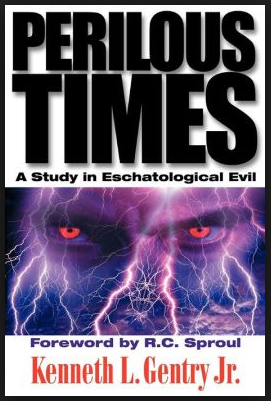
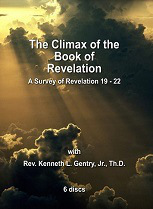








November 4, 2016
THOSE WHO DWELL ON THE EARTH (3)
 PMT-2016-81 by Kenneth L. Gentry, Jr.
PMT-2016-81 by Kenneth L. Gentry, Jr.
In Revelation we have an interesting phrase that occurs time and again, and which plays an important role in the drama. This is the third in a short series analyzing the phrase and its significance for the redemptive-historical preterist view of Revelation that I hold.
But now let’s continue by beginning to consider the issue directly as we look at:
The “Land-dwellers” in Revelation
Of the twelve appearances of gē linked with katoikia, four of them quite clearly refer to the Jews in the Land of Israel (3:10; 6:10; 11:10 [2x]), two of them (13:7–8 and 14:6) seem strongly to refer to Israel, and two (17:2, 8) could very well do so. The remaining four references could go either way, but in light of the clearer allusions and John’s using the phrase as a recurring technical designation, they surely designate the same people.
First, the clear allusions. The first clear reference is 3:10. This verse not only offers clear evidence toward the Jew-focused interpretation, but happens to be John’s first use of this recurring technical phrase. It will be helpful to present the phrase in its context:
“And to the angel of the church in Philadelphia write: He who is holy, who is true, who has the key of David, who opens and no one will shut, and who shuts and no one opens, says this: I know your deeds. Behold, I have put before you an open door which no one can shut, because you have a little power, and have kept My word, and have not denied My name. Behold, I will cause those of the synagogue of Satan, who say that they are Jews and are not, but lie — I will make them come and bow down at your feet, and make them know that I have loved you. Because you have kept the word of My perseverance, I also will keep you from the hour of testing, that hour which is about to come upon the whole world, to test those who dwell on the earth. I am coming quickly; hold fast what you have, so that no one will take your crown.” (3:7–10)
Charismatic Gift of Prophecy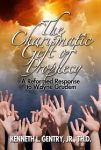
(by Kenneth Gentry)
A rebuttal to charismatic arguments for the gift of prophecy continuing in the church today. Demonstrates that all revelatory gifts have ceased as of the conclusion of the Apostolic era.
See more study materials at: www.KennethGentry.com
Besides all the previous argument regarding the use of gē in this highly Hebraic work, I would point out the following supporting evidence. I would introduce the evidence by nothing that this first use of Land-dwellers is set in what is inarguably the most Jewish of the seven oracles. In itself this opens up the strong likelihood that the phrase is itself a Jewish designation.
(1) This oracle opens with Christ’s Messianic declaration that he holds the “key of David” and that he alone can and open and shut the kingdom to men (3:7).
(2) This is one of two oracles that strongly denounces the Jews as composing a “synagogue of Satan” and being false Jews (3:9a; cp. 2:9).
(3) Immediately after this denunciation he promises that he will subjugate these Jews (3:9b) in such a way that they will know that he loves the Christian (3:9c).
(4) He sets the Land-dwellers over against “the whole world” in a synthetic parallelism: “I also will keep you from the hour of testing, that hour which is about to come upon the whole world, to test those who dwell on the earth” (3:10b, c). In this regard I would note that “the whole world” is a translation of oikoumenē holēs. This does not require a truly global conflagration. This is the only place in the NT where katoikountēs occurs with oikoumenē holēs. But oikoumenē often means simply the Roman empire, not the whole world and all seven continents. This is true of even global-sounding statements very similar to that in 3:10. For instance, in Mt 24 and Ac 11 we do discover very similar expressions (though lacking any reference to katoikountēs).
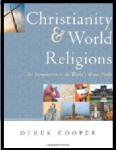
Christianity and the World Religions:
By Derek CooperCooper. Examines the rival worldviews found in Hinduism, Buddhism, Confucianism and Taoism, Judaism, Islam, and irreligion. He engages these worldviews from a Christian perspective.
See more study materials: www.KennethGentry.com
In Mt 24:14 we learn that the gospel “shall be preaching in the whole world [en holē tē oikoumenē].” This speaks of the Roman empire as we can see by interpreting it in the light of Col 1:6, 23 (cp. Ro 1:8) and due to its near-term limitation (Mt 24:2, 34). In Ac 11:28b we read of Agabus’ prophecy of a coming “great famine all over the world [holēn tēn oikoumenēn].” The next words after this are: “and this took place in the reign of Claudius” (Ac 11:28c). Thus, Rev 3:10 is speaking of an empire-wide hour of testing (not a global testing) that will especially focus on the Land-dwellers. Furthermore, Land-dweller and “whole world” statements are not synonymous parallels repeating the same fact. Rather they are synthetic parallels with the second one adding to the first statement (Penley 113, 115). Indeed, though the world/Roman empire will be tested in the near future, the ultimate design of “the hour of testing” is to test those who dwell in the Land (as per Rev’s theme, 1:7).
(5) He expressly promises that this will all occur soon: it “is about to come” (3:10b) and it will come “quickly” (3:11a).
(6) All of this love of the saints and the judgment on the Land-dwellers (the false Jews of the synagogue of Satan) will result in the saints’ entry into the new Jerusalem in heaven above (3:12d, e).
(7) As noted previously the Land-dweller language derives from Hos 4:1 (LXX) which is (a) clearly directed against “the Sons of Israel” (Hos 4:1a) and (b) represents a legal “case [ribh] against the inhabitants of the land” (Hos 4:1b). This perfectly matches what is occurring in Rev, which is a forensic drama presenting God’s judgment against Israel.
In the next article I will consider the second point in this regard. Stay tuned.









November 2, 2016
THOSE WHO DWELL ON THE EARTH (2)
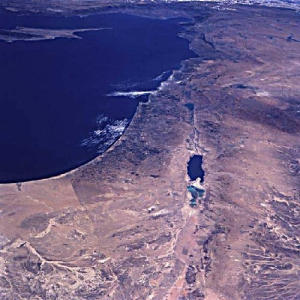 PMT 2016-080 by Kenneth L. Gentry, Jr.
PMT 2016-080 by Kenneth L. Gentry, Jr.
This is the second article in a short series on a recurring phrase in Revelation, generally translated “those who dwell on the earth.” I am arguing that it should be translated “those who dwell in the Land,” i.e., of Israel. For brevity I translate the whole phrase as “Land-dwellers.” In this article I will begin with:
“The Land” in Revelation
Before discussing the Land in Rev I would remind the reader of Rev’s strongly Judaic character. As I argue in the Introduction (as per most commentators) Rev is wholly saturated with OT allusions, strongly expressed in terms of Hebraic syntactical peculiarities, and brightly colored by Judaic images. John also presents his work as a forensic drama wherein he is presenting a covenant lawsuit from God. All of this prepares us for recognizing the possible use of the Land as an important image in this remarkable work and the Land-dwellers as the recipients of most of its judgments.
In my last article I pointed out that in Rev the Greek hē gē most often refers to the Land of Israel rather than to the generic earth, though like the Hebrew term ‘eretz, it could go either way. In my commentary not yet published) I will provide a chart that sorts out the uses of hē gē in Rev, noting that 64% of them seem clearly to refer to the Land of Israel and 6% of them are uncertain. There I also argue that the recurring phrase “the kings of the earth” (tōn basileōn tēs gēs, Rev 1:5) refers to the religious rulers of the Land. I agree with Buchanan (118) that it is “obvious that the promised land is the central geographical unit in the Book of Revelation.”

As It Is Written: The Genesis Account Literal or Literary?
Book by Ken Gentry
Presents the exegetical evidence for Six-day Creation and against the Framework Hypothesis.
See more study materials at: www.KennethGentry.com
All of this opens the possibility of interpreting “those who dwell upon the earth” (tous katoikountas epi tēs gēs) and similar expressions as always denoting the Jews who live in the Promised Land. And as we shall see, John appears to draw his first appearance of Land-dwellers in 3:10 from Hos 4:1. This is significant in that it not only links the Land-dwellers to the OT but to a covenant lawsuit against Israel. But more on this later.
The “Land-dwellers” in the OT
As he comments on the first appearance of “Land-dwellers” in Rev 3:10, Hort (35; cp. Charles, 1:289; Thomas 1:289n) suggests that John derives this phrase from Hos 4:1 (LXX). Other commentators recognize its general OT backdrop (e.g., Swete 56; Aune 240). Hos 4:1 clearly speaks of rebellious Israel (though Hort applies 3:10 to the wider world): “Listen to the word of the LORD, O sons of Israel, / For the LORD has a case against the inhabitants of the land [tous katoikountas tēn gēn], / Because there is no faithfulness or kindness / Or knowledge of God in the land [epi tēs gēs].”
In the LXX, references to Israel as the Land-dwellers occur often, with the phrasing including epi (as generally in Rev) in Jer 1:15; 6:12; Eze 7:7; Zep 1:8; Zec 11:6 (though without epi in Hos 4:1a; Jer 10:18; Joel 1:2, 14; 2:1). The phrase frequently applies to idolatrous pagans — although specifically to those dwelling in the Land (Nu 32:17; 33:52, 55; Jos 7:9; 9:24; Jdg 1:32; 2Sa 5:6; 1Ch 11:4; 22:18). Buchanan (128) observes that “the great majority of cases, however, identify [the Hebrew phrase] as those who lived on the land of Palestine (Exod 23:31; 34:12, 15; Josh 2:9, 24; 6:12; 7:9; 9:14; 10:18; 13:21; 24:18; 25:29, 30; Judges 1:32–33; Ezek 7:7; Hos 4:1; Joel 1:2, 14; 2:1; Zech 11:6) and should be rendered ‘inhabitants of the land’ rather than ‘inhabitants of the earth.” Thus we see how the Land-dweller phrase speaks of people in the Land, i.e., the Promised Land.
Against those who would interpret this phrase broadly to cover people throughout the world, Penley (108) notes of the similar phraseology in the LXX: This combination “consistently refers to a specific land region in which a tribe or people group lives. . . . The land region could be as large as Canaan or as small as a single city” (Penley 108). In fact, he points out that twenty-two times these two words (gē and katoikia) also appear with the preposition epi (as in Rev and Lk 21:35 [see below]): Ge 47:27; Lev 18:3; 20:22; 25:10, 18, 19; 26:5; Num 13:32; 14:14; 33:55; 35:32, 34; Dt 2:20; 12:10; 17:14; 26:1; 30:20; Jos 9:24; 22:3; 24:15; 1Ki 8:27; 2Ch 6:18. Only one of these (Lev 18:3) applies to a place other than the Promised Land (but there it speaks of the Jews dwelling in Egypt).
The Book of Revelation Made Easy
(by Ken Gentry)
Helpful introduction to Revelation presenting keys for interpreting. Also provides studies of basic issues in Revelation’s story-line.|
See more study materials at: www.KennethGentry.com
The two references most similar to the Rev phrases are Nu 14:14 (pantes hoi katoikountes epi tēs gēs tautēs) and 33:55 (tous katoikountas epi tēs gēs) which refer to the people in Canaan before Israel conquers them. And when using the Hebrew texts containing the Hebrew form of the words: “the most common referent in the prophets is the inhabitants of the land of Israel not all the inhabitants of the earth” (Penley 109). See: La 4:12; Hos 4:1; Joel 1:2, 14; 2:1; Isa 9:1; 21:14; 24:6, 17; 26:21; Jer 1:14; 6:12; 10:18; 13:13; 25:29, 30; 38:11; Eze 7:7; Da 4:35; Zep 1:18; Zec 11:6.
Thus the OT source of this Land-dweller phrase most often speaks of the Promised Land and of the Jews who are its inhabitants. I believe that this is the way John employs the phrase.
In my next article I will focus on the “Land-dwellers” in Revelation.









October 28, 2016
THOSE WHO DWELL ON THE EARTH (1)
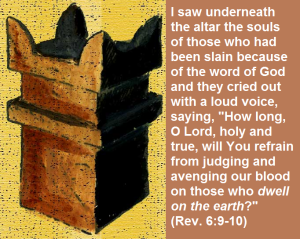 PMT 2016-079 by Kenneth L. Gentry, Jr.
PMT 2016-079 by Kenneth L. Gentry, Jr.
In Revelation we frequently read about “those who dwell upon the earth.” This is an important recurring phrase that serves as a terminus technicus for John. It occurs twelve times in seven closely related grammatical forms (3:10; 6:10; 8:13; 11:10 [2 x]; 13:8, 12, 14 [2x]; 14:6; 17:2, 8). The form we have here at 6:10 is: tōn katoikountōn epi tēs gēs. Elsewhere we find the following:
tous katoikountas epi tēs gēs (3:10; 8:13; 11:10b; 13:14a)
hoi katoikountes epi tēs gēs (11:10a; 13:8; 17:8)
tois katoikousin epi tēs gēs (13:14b)
tēn gēn kai tous en autē katoikountas (13:12)
tous kathēmenous epi tēs gēs (14:6)
hoi katoikountes tēn gēn (17:2).
The variations are minor, due largely to case changes necessary for fitting them into their several contexts, though epi does not appear in 13:12 and 17:2.
The vast majority of commentators interpret this phrase as applying broadly to the human race in its opposition to God (Gill 711; Alford 586; Hort 35; Mounce 103, 148; Morris 79; Beale 290; Kistemaker 163; Harrington 71, Thomas 1:289; Keener 151; Smalley 92; Osborne 193; Resseguie 98–99; Boxall 73).

Navigating the Book of Revelation (by Ken Gentry)
Technical studies on key issues in Revelation, including the seven-sealed scroll, the cast out temple, Jewish persecution of Christianity, the Babylonian Harlot, and more.
See more study materials at: www.KennethGentry.com
But we do find a number of able scholars who dispute this universal description. The following interpret the phrase as referring to those who live in the Land of Israel (some only in a passage or two, others more fully): Stuart (2:161, 236), Russell (1887: 394), Charles (1:289–90), Carrington (131, 157), Ford (180), Beagley (68), Chilton (282), Van De Water (245–61), Malina (61–62, 128, 147), Lupieri (159, 223), Penley (105–19), and Buchanan (111, 175). Interestingly, even the dispensationalist work Doomsday Delusions (Pate 1995: 49) argues regarding 6:10: “while the phrase can mean ‘the inhabitants of the world,’ the more likely meaning of the phrase in Revelation 6:10 is ‘the inhabitants of the land [Palestine].”
But how does this phrase function for John? Reflecting his OT backdrop, John takes up the prophetic mantel and like the prophets of old once again charges Israel with idolatry in the new covenant era. He effectively denounces the Jews basically as “unbelieving idolaters,” to use Beale’s phrase but in a different way. In John’s forensic drama this idolatry charge applies to the Jews whom he deems organized as a “synagogue of Satan” who only falsely claim to be true Jews (2:9; 3:9). Indeed, their holy city is designated “Sodom and Egypt” (11:8) — and “Babylon” (16:9; 17:5).
Before Jerusalem Fell
(by Ken Gentry)
Doctoral dissertation defending a pre-AD 70 date for Revelation’s writing. Thoroughly covers internal evidence from Revelation, external evidence from history, and objections to the early date by scholars.
See more study materials at: www.KennethGentry.com
Throughout his Gospel John shows that Jesus constantly calls upon Israel to believe (Jn 1:7; 3:18; 6:35–36; 8:24; 12:46; 20:31). Sadly though, both the rulers and the majority of the people reject him and remain in unbelief (Jn 5:38, 44, 47; 8:45; 10:25; 12:37–39; 16:9). He eventually declares of Israel’s religious leaders: “you are of your father the devil” (Jn 8:44). In the end the Jews cry out against Christ and before the Roman procurator Pilate: “We have no king but Caesar” (Jn 19:15). In this they prefer over Christ the emperor Tiberius who is descended from the “deified Julius” and “deified Augustus” (Suet., Lives, bks 1 and 2). And this despite his predecessor Augustus being “given honors equal to those of the Olympian gods” (Philo, Embassy 22 §149–50). Jesus implicitly warns them not to give to Caesar the things that belong to God, i.e., worship (Mt 22:17–21).
All of this parallels Rev’s even more scathing denunciation of Israel. In Revelation Jerusalem sides with idolatrous Rome (Rev 17:3) and persecutes Christ’s followers (17:6).
“The Land”
I will analyze the Land-dweller phrase in its biblical setting to show its powerful rhetorical function in Rev. I will begin by briefly considering the Land in the OT, where our phrase first occurs. Then I will move from considering the Land to focusing on the Land-dweller phrase.
Everyone understands the significance of the Land to Israel and its important role in the OT. It first appears in the Abrahamic Covenant as a key feature of God’s blessing upon him and his descendants: “Now the LORD said to Abram, / ‘Go forth from your country, / And from your relatives / And from your father’s house, / To the land which I will show you” (Ge 12:1). As a consequence of this and the fuller biblical revelation of God’s covenant with Israel, we understand that “the land of Israel belonged to Judaism’s understanding of itself” (DLNTD (642). Indeed, “the Holy Land is a central category in Judaism” (DJBP 323). Scripture often call this Land an “inheritance” from God (Nu 34:2, 29; 36:2; Dt 3:28; 4:21; 15:4; 19:14; 25:19; 31:7; 1Sa 26:19; 2Sa 14:16; 1Ki 8:36; 1Ch 16:18; Ps 68:9; 79:1; 105:11; Jer 2:7; 3:18; cp. Ac 13:19).
Stuart (2:161) notes regarding the Hebrew word for Land (ha’aretz): “the meaning . . . may be general or particular, just as the context requires. The Hebrews, who in prose used only one word (‘eretz) for earth, country, region, etc. never found any difficulty in this, because the context of course limits or expands it, just as the case may require.” Thus a general, broad term often functions as a specific, focused designation for Israel’s God-given gift. The Land is called the “holy land” in Ps 78:54; Zec 2:12; 2 Mac 1:7; Wisd 12:3; Bib. Ant. 9:10; 2 Bar 71:7; 84:8. The Land is called: his/my/the Lord’s land in Lev 25:23; Dt 32:43; Ps 10:16; Jer 2:7; 16:18; Eze 36:5, 20; 38:16; Hos 9:3; Joel 2:18; 3:2; and Zec 9:16. Clearly the Land is a greatly-beloved feature of God’s love for Israel.
But now, how does this affect our understanding of Revelation?
To be continued.









October 26, 2016
REFUGEES CONVERTING TO CHRIST
 PMT 2016-078 by The Guardian
PMT 2016-078 by The Guardian
A growing number of Muslim refugees in Europe are converting to Christianity, according to churches, which have conducted mass baptisms in some places.
Reliable data on conversions is not available but anecdotal evidence suggests a pattern of rising church attendance by Muslims who have fled conflict, repression and economic hardship in countries across the Middle East and central Asia.
Complex factors behind the trend include heartfelt faith in a new religion, gratitude to Christian groups offering support during perilous and frightening journeys, and an expectation that conversion may aid asylum applications.
At Trinity church in the Berlin suburb of Steglitz, the congregation has grown from 150 two years ago to almost 700, swollen by Muslim converts, according to Pastor Gottfried Martens. Earlier this year, churches in Berlin and Hamburg reportedly held mass conversions for asylum seekers at municipal swimming pools.
The Austrian Catholic church logged 300 applications for adult baptism in the first three months of 2016, with the Austrian pastoral institute estimating 70% of those converting are refugees.
The Beast of Revelation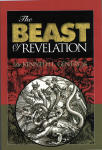
by Ken Gentry
A popularly written antidote to dispensational sensationalism and newspaper exegesis. Convincing biblical and historical evidence showing that the Beast was the Roman Emperor Nero Caesar, the first civil persecutor of the Church. The second half of the book shows Revelation’s date of writing, proving its composition as prior to the Fall of Jerusalem in A.D. 70. A thought-provoking treatment of a fascinating and confusing topic.
For more study materials, go to: KennethGentry.com
At Liverpool’s Anglican Cathedral in the UK, a weekly Persian service attracts between 100 and 140 people. Nearly all are migrants from Iran, Afghanistan and elsewhere in central Asia.
One in four confirmations conducted by the bishop of Bradford, Toby Howarth, over the past year were of converts from Islam. Most were Iranian and most of those were asylum seekers.
Mohammad Eghtedarian, a curate at Liverpool Cathedral and a refugee from Iran who converted to Christianity and was later ordained, said the church was helping people to develop their faith and to apply for refugee status. “These two are intertwined. Most people apply for asylum on the basis of their religion,” he said.
His own journey, from the Iranian city of Shiraz to the UK, took him through half a dozen European countries, by truck, train and on foot. Destitute and terrified, he was offered practical and emotional support from Christians along the way.
Before being granted asylum, Eghtedarian spent four months in Tinsley House detention centre, near Gatwick airport. “Every day was challenging and beautiful. Challenging because I didn’t know if they would deport me; beautiful because I was in the Lord’s hands. I promised the Lord: if you release me, I will serve you.”
Now he devotes himself to helping other refugees. “People are desperate. They spend a lot of money and waste a lot of money. They are vulnerable, abused and sometimes [they have been] raped.” The experience of being a refugee was degrading and dehumanising, he said.
Blessed Is He Who Reads: A Primer on the Book of Revelation
By Larry E. Ball
A basic survey of Revelation from the preterist perspective. It sees John as focusing on the destruction of Jerusalem and the temple in AD 70.
See more study materials at: www.KennethGentry.com
Johannes, another Iranian, left Tehran for Vienna. Born into a Muslim family, the 32-year-old – who was previously called Sadegh – began questioning the roots of Islam at university. “I found that the history of Islam was completely different from what we were taught at school. Maybe, I thought, it was a religion that began with violence?
To read rest of report:
https://www.theguardian.com/world/2016/jun/05/european-churches-growing-flock-muslim-refugees-converting-christianity
Click on the following images for more information on these studies:


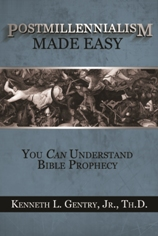








October 14, 2016
GENDER, GOD’S WILL AND POSTMILLENNIALISM
 PMT 2016-077 by Kenneth L. Gentry, Jr.
PMT 2016-077 by Kenneth L. Gentry, Jr.
In my last article I introduced the problem of cultural collapse as indicated by the transgender phenomenon. In this article I will briefly highlight the biblical argument against transgender ideology. In that postmillennialism is biblically-rooted eschatological system which seeks a God’s-law governed moral system, postmillennialists need to understand the issues. So now let us consider transgenderism and:
The Divine Prohibition
For Christians the most important observations on trans-gender issues, though, come from God’s Word itself. Scripture speaks expressly against transgender behavior. It presents it as a sin that cries out for release through redemption and counseling.
Transgenderism is prohibited by creation design. As already noted, transgender conduct is contrary to the God-ordained order from the very beginning of creation. Genesis 1:27 states: “God created man in His own image, in the image of God He created him; male and female He created them.”
Transgenderism is prohibited by God’s Law. Divine laws established against homosexual conduct naturally include transgender activities. Leviticus 18:22 is clear: “You shall not lie with a male as one lies with a female; it is an abomination.”

Covenantal Theonomy
(by Ken Gentry)
A defense of theonomic ethics against a leading Reformed critic. Engages many of the leading objections to theonomy.
See more study materials at: www.KennethGentry.com
And this law continues in the New Testament where we read Paul’s statement regarding the gospel and sound doctrine: “We know that the Law is good, if one uses it lawfully, realizing the fact that law is not made for a righteous person, but for those who are lawless and rebellious, for the ungodly and sinners, for the unholy and profane, for those who kill their fathers or mothers, for murderers and immoral men and homosexuals and kidnappers and liars and perjurers, and whatever else is contrary to sound teaching, according to the glorious gospel of the blessed God, with which I have been entrusted” (1 Timothy 1:8–11).
Transgenderism is prohibited by biblical morality. In Deuteronomy 22:5 Moses states: “A woman shall not wear man’s clothing, nor shall a man put on a woman’s clothing; for whoever does these things is an abomination to the LORD your God.” This is not a fashion statement. It does not condemn women wearing jeans. This is a moral statement. It prohibits passing off one oneself as the opposite gender.
We see this moral requirement reappearing in the New Testament. In 1 Corinthians 11:14–15 Paul state: “Does not even nature itself teach you that if a man has long hair, it is a dishonor to him, but if a woman has long hair, it is a glory to her? For her hair is given to her for a covering.” By “nature” here, Paul means social mores, cultural expectations. This is obviously the case in that nature does allow male and female hair to grow long.
Paul is pressing the moral values of Deuteronomy 22:5 regarding social conduct and decorum. Long hair conveyed sexual ambiguity and moral perversion. In antiquity it was worn by male transgenders and homosexual prostitutes. For instance, Epictetus (d. 135) commented: “Are you a man or woman? We ought not to confuse the sexes which have been distinguished in this fashion.” The first-century Jewish philosopher Philo warned of “the disease of effemination” (Special Laws 3:7:37–38).
Transgenderism is prohibited by divine warning. In 1 Corinthians 6:9–10 Paul states: “Do you not know that the unrighteous will not inherit the kingdom of God? Do not be deceived; neither fornicators, nor idolaters, nor adulterers, nor effeminate, nor homosexuals, nor thieves, nor the covetous, nor drunkards, nor revilers, nor swindlers, will inherit the kingdom of God.” The word “effiminate” is a translation of the Greek word malakoi which means “soft men.” That is, men desiring femininity.
The Biblical Counsel
How shall Christians argue the biblical case against transgenderism? How can we counsel transgenders and homosexuals who claim to be Christian — even while they freely engage in this conduct?
Point them to the teaching of the Bible. The Bible is clear. And the true Christian will accept it as God’s Word. We should not let them waffle with a “Yes, but….” This of course will require that Christians know their Bibles.
Warn them not to claim they were “born that way.” Modern thought claims most reprehensible sins are genetically-determined. Medical scientists today are beginning to declare that pedophiles are born that way. Shall pedophilia be tolerated on this basis? And think of violent crime. Ninety percent of violent crimes are committed by men. And this is influenced by testosterone. Shall we allow violence since men are “born that way”?
Urge them to live by the Bible. In all of life. Remind them that John warns: “If we say that we have fellowship with Him and yet walk in the darkness, we lie and do not practice the truth.” Jesus present God’s Word as a sanctifying influence. In John 17:17 he prays: “sanctify them in the truth; Your word is truth.”

Getting the Message
(by Daniel Doriani)
Presents solid principles and clear examples of biblical interpretation.
See more study materials at: www.KennethGentry.com
Life can be difficult, to be sure. Paul struggled with covetousness. But he did struggle against it; he did not give in and pursue his covetous desires (Rom. 7:21–25).
Promise them hope in true redemption. Paul pointed out the power of the gospel to claim homosexuals and transgenders. To the Corinthians he wrote: “Do you not know that the unrighteous will not inherit the kingdom of God? Do not be deceived; neither fornicators, nor idolaters, nor adulterers, nor effeminate, nor homosexuals…. Such were some of you; but you were washed, but you were sanctified, but you were justified in the name of the Lord Jesus Christ and in the Spirit of our God” (1 Cor. 6:9, 11).
America needs a true Christian revival. The church needs a fundamental Reformation. Let’s pray God grants both. Soon. Otherwise our hope must await the next generation.
Click on the following images for more information on these studies:
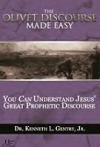

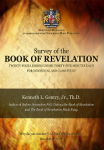








October 11, 2016
GENDER, CULTURAL COLLAPSE AND POSTMILLENNIALISM
 PMT 2016-076 by Kenneth L. Gentry, Jr., Th.D.
PMT 2016-076 by Kenneth L. Gentry, Jr., Th.D.
The postmillennial hope is rooted in God’s word, not man’s world. Postmillennialism expects ups-and-downs as his unfolds. Though eventually the advances will far outweigh the declines. However, currently we are witnessing a downward trend in our cultural.
Our culture is now in such a state of rebellion against God that it cannot even tell the difference between male and female, such is the blindness of unbelief. The postmillennial hope involves a deep and abiding commitment to God’s word and his law to shine a light on our path forward. Unfortunately, so many Christian churches have become so invested in fun and entertainment instead of worship and study that Christians are confused in how to respond to our collapsing culture.
In this article I will focus on one of the most remarkable moral errors of our day: the affirmation of transgender ideology. We must understand its error in order to critique it, rebut it, and move beyond it.
Gender Identity is the latest rage among postmodernists. Especially since the June 2015 transformation of Bruce Jenner from a male to the female Caitlyn Jenner, transgender discussions have exploded on the scene. And many Christian leaders and laymen have gotten on the politically-correct bandwagon. But what does the Bible have to say about this phenomenon? Much, in every way.
The Creation Expectation
In Genesis 1:27 we read: “God created man in His own image, in the image of God He created him; male and female He created them.” This statement most clearly presents God’s creation design for the human race. He established gender as a binary distinction within mankind. He established them as two distinct kinds.
The word “gender” is derived from the Latin genus, which means “kind, type.” Thus, God established two kinds of people: male and female. And then he declared this (and all else that came from his creative activity): “very good” (Gen. 1:31).

As It Is Written: The Genesis Account Literal or Literary?
Book by Ken Gentry
Presents the exegetical evidence for Six-day Creation and against the Framework Hypothesis.
See more study materials at: www.KennethGentry.com
This truth is re-iterated later in summarizing man’s creation. Moses introduces the first genealogy in Scripture, which traces Adam’s multiplying in the earth (per God’s command, Gen 1:28). And there we once again hear his declaration: “He created them male and female, and He blessed them and named them Man in the day when they were created” (Gen . 5:2). Then follows the genealogy of the early human race from Adam to Noah.
We must recognize that this genealogical development is essential to redemption. For this genealogy begins unfolding throughout the Old Testament, reaching into the New, leading to the birth of Jesus. His birth would have been impossible on either a homosexual or transgender principle, for birth requires opposite genders. The whole story of redemption requires a seed, and in the God-created order, seed requires gender distinctions.
Jesus himself confirms this original creation order when he declares: “from the beginning of creation, God made them male and female” (Mark 10:6).
Gender identity is a part of the creation order and lends itself to a strong creation theology which arises from Genesis 1–2. The further we depart from God’s creation design, the worse things will go for us. Man cannot shake his fist in the face of God with impunity. In this regard we should remember God’s rebuke of Job. God issues a thundering challenge to his stumbling servant: “Then the LORD said to Job, ‘Will the faultfinder contend with the Almighty? Let him who reproves God answer it’” (Job 40:1–2).
We live in a God-designed and God-created world under God-appointed laws. Rejecting the divine order can only lead to our peril.
Our Current Predicament
Sin complicates matters; life is not simple with sin present Sin disrupts all of life’s activities, causing broken marriages, crime, war, and more. And today sin is even complicating the most basic identity of man as male and female.
Until fairly recently, all agreed there were two genders. And if you check any obstetrics ward you will find two genders represented there. But sin elevates the subjective over the objective, desire over reality. And the Bible calls this elevation: lust.
 Blame It on the Brain?
Blame It on the Brain?
Sub-title: Distinguishing Chemical Imbalances, Brain Disorders, and Disobedience
by Edward T. Welch
Depression, Attention Deficit Disorder, Alcoholism, Homosexuality.
Research suggests that more and more behaviors are caused by brain function or dysfunction.
But is it ever legitimate to blame misbehavior on the brain?
How can I know whether my brain made me do it?
See more study materials at: www.KennethGentry.com
Genesis 1 speaks of two objective, actual, God-ordained genders. But recent, avant-garde psychology does not. We are now hearing that gender identity is a subjective experience. The American Psychological Association defines the matter thus: “Gender identity is a person’s private sense and subjective experience of their own gender. Gender identity refers to a person’s internal sense of being male, female or something else.” It continues by noting that gender “expression refers to the way a person communicates gender identity to others through behavior, clothing, hairstyles, voice or body characteristics.” (http://www.apa.org/topics/lgbt/transgender.aspx)
In 1984 Dr. N. W. Fisk was the first professional to diagnose “Gender Dysphoria.” The word “dysphoria” is based on two Greek words: dus (“difficult”) and pherein (“to bear). “Gender dysphoria” is one’s unhappiness, unease, or dissatisfaction with his or her biological sex, which makes one’s personal life “difficult to bear.”
Previous to our times, one’s sexual identity and role was understood to be one of two particular, non-overlapping characteristics: male or female. But today, the increasing rejection of God and morality has encouraged sin’s integration downward into the void. As sin “gets its act together,” it moves more rapidly into destruction. Tragically, many today are arguing for multiple genders, and unlimited blended continuum.
This recent approach to gender is not simply a bizarre annoyance. It cannot be written off as a sad situation. It is impacting society, especially in education and law — with enormous cultural consequences. As our nation moves further and more rapidly away from God, things will trend more quickly from bad to worse.
We see gender corruption in education. Our northern neighbor Canada has progressed further down this path than we have. The British Columbia Teachers Federation’s Handbook on Gender Education, notes that “Gender is a product of the mind…. Being transgender or gender-non-conforming is normal and healthy.” It warns of “outdated and oppressive views of gender-continuity that circulate in our everyday understanding of what it means to be human.”
And how does this Handbook recommend guarding against oppressive (God-ordained) views? It recommends “access to safe restroom and locker room facilities that correspond to one’s gender identity.”
But American liberal educational theorists are not to be outdone. Redwood Heights Elementary School in Oakland, California, has appointed “gender coaches” to teach young children that “you can be a boy or a girl, or both.” In fact, the United States National Education Association president recently stated at a national convention: “comprehensive sex education is the only way to combat heterosexism and gender conformity. We must make these issues a part of every middle and high school student’s agenda. Gender identity express and sexual orientation is a spectrum. And those opposed to homosexuality are stuck in a binary box that religion and family create.”
We see gender corruption in law. A January 2014 California law “guarantees students in K-12 the right to use the school restrooms and to participate in the sex-segregated activities that correspond with their expressed genders instead of their school records.”
Such laws exist in Massachusetts and Connecticut. And they even go further. According to the February 25, 2014 Huffington Post: “Some school districts take the law as a mandate to evaluate sleeping arrangements for overnight field trips and activities such as choirs and recreational sports where girls and boys are often separated.”
A slightly earlier Huffington Post article (January 31, 2014) stated: “School officials violated state anti-discrimination law when they would not allow a transgender fifth-grader to use the girls’ bathroom, according to a ruling by the highest court in Maine.”
In Maryland a similar 2014 law was rightly complained against. According MSNBC: House Minority whip Kathy Szeliga sated: “We should be very concerned about the safety of women and little girls, because what this allows is that possible predators and pedophiles can go in our women’s restrooms.”
We hear much today about school bullies. And bullying is a sad situation. But how is the law responding to this social problem? What are they recommending? And who is pushing anti-bullying laws?
A June 4, 2011, WND article noted that “The anti-bullying bills being passed in haste across the country force a range of draconian fixes on public schools. The main force (and funding) behind this national push has been the homosexual and transgender movements.”
A CBN News release on May 24, 2012, reported that Illinois state senator Kyle McCarter helped stop a bill in 2012. McCarter warned that “there are anti-bullying programs that have an agenda: to only protect one class of individuals. Some of these programs are very good. They indeed encourage kids not to bully. But there are program throughout the United States, used in some high schools and universities, that really have just a pro-homosexual agenda, and nothing but that.”
But now what does God’s word teach us about the matter? That is the question to be settled in my next article.
Click on the following images for more information on these studies:











October 7, 2016
COMMISSION AND SOVEREIGNTY (3)
 PMT 2016-075 by Kenneth L. Gentry, Jr.
PMT 2016-075 by Kenneth L. Gentry, Jr.
This is the third installment of a three-part mini-series on sovereignty in the Great Commission. As a New Testament cornerstone for the postmillennial hope, the Great Commission requires careful consideration. And in that consideration we must note how it is permeated with divine sovereignty. In this article I will consider sovereignty and:
Its Literary Context
The beautiful structure of Matthew’s Gospel merits our attention as we consider the Great Commission. Blair comments regarding Matthew 28:18ff: “Here many of the emphases of the book are caught up.” Cook concurs: “With this sublime utterance St. Matthew winds up his Gospel, throughout which he has kept the principles, which are thus enunciated, distinctly before our minds.”
I would go a step further and note that what we read in the closing words of Matthew’s Gospel in the closing days of Christ’s ministry has already been anticipated in the opening words of the Gospel and of Christ’s earthly life and the beginning of His ministry. Thus, the very opening chapters of Matthew seem to expect the conclusion we get in the Great Commission. Let me just briefly draw out the parallels; they do not seem to be merely coincidental. They speak of a King who comes (Matt. 1-4) and receives sovereignty (Matt. 28) over a kingdom.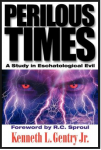
Perilous Times: A Study in Eschatological Evil (by Ken Gentry)
Technical studies on Daniel’s Seventy Weeks, the great tribulation, Paul’s Man of Sin, and John’s Revelation.
See more study materials at: www.KennethGentry.com
1. Jesus as “Immanuel.”
A. In the birth announcement to Joseph, we have the angelic declaration of the fulfillment of Isaiah 7:14 in Jesus’s birth: “Behold, the virgin shall be with child, and shall bear a Son, and they shall call His name Immanuel,” which translated means, ‘God with us'” (Matt. 1:23). “God with us” has come! B. In the conclusion of Matthew and in the Great Commission, we have the same theme: “And, lo, I am with you always” (Matt. 28:20b). “God with us” remains!
2. The Royalty of Jesus.
A. In Matthew 1:1 the royal genealogy of Christ is pushed forward: “The book of the genealogy of Jesus Christ, the son of David, the son of Abraham.” Here not only do we have Christ’s human name (“Jesus”) coupled with His Messianic name (“Christ”), but with the royal title “Son of David,” which is a familiar Messianic ascription to Christ in Matthew. As Hendriksen comments: “The genealogy presented in Matt. 1:1-17 is not an appendix but is closely connected with the substance of the entire chapter; in a broader sense, with the contents of the entire book.”
B. In Matthew 28:18 Christ comes to His disciples in the exercise of His recently secured royal authority: “All authority is given Me in heaven and on earth.” A fitting conclusion to a work opening with a royal genealogy.
3. Gentiles and the King. A. In Matthew 2:1ff we read of gentile magi coming from “the east” in search of Christ. They seek Him “who has been born King of the Jews” (Matt. 2:2a). B. In Matthew 28:19 we read of the sovereign King with “all authority in heaven and earth” sending His disciples in search of the gentiles: “Go, make disciples of all the nations.”
4. Christ Attacked. A. In Matthew 2 we read of a king’s attempted destruction of the young Jesus toward the beginning of His earthly sojourn: “Herod is going to search for the Child to destroy Him” (Matt. 2:13b). B. The Great Commission was given after the final attempted destruction of Christ by means of the crucifixion (Matt. 27:33ff) toward the end of His earthly ministry.
5. Israel Replaced by the Nations. A. In Matthew 3:9-11 John Baptist warns the Jews in Judea, who were so proud of their Abrahamic descent, that “the axe is already laid at the root of the trees” and that there was coming a fiery destruction of Jerusalem. B. In the Great Commission, Christ, the true Son of Abraham, while in Galilee (v. 16) after the Jews lied about His resurrection (vv. 12-15), commands His followers to “Go therefore and make disciples of all the nations” (Matt. 28:19).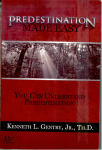
Predestination Made Easy
(by Ken Gentry)
A thoroughly biblical, extremely practical, and impressively clear presentation of
the doctrine of absolute predestination.
See more study materials at: www.KennethGentry.com
6. Geographical Juxtaposition. A. In Matthew 3 Christ’s first public appearance opens with these words: “Then Jesus arrived from Galilee at the Jordan” (Matt. 3:13). His movement was from Galilee to Judea (Matt. 3:1). B. In the closing of Matthew and His ministry as recorded there, Christ’s movement is the opposite: He moves from Jerusalem in Judea to Galilee (Matt. 28:1, 6-7, 10, 16).
7. Baptismal Ritual. A. As Christ’s public presentation opens in Matthew, we read: “Then Jesus arrived from Galilee at the Jordan coming to John, to be baptized by him” (Matt. 3:13). B. In the closing of Christ’s ministry in Matthew, we read: “Go therefore and make disciples of all the nations, baptizing them” (Matt. 28:19).
8. The Trinity. A. At Christ’s baptism we have one of the Scripture’s clearest evidences of the Trinity: “After being baptized, Jesus [the Son] went up immediately from the water; and behold, the heavens were opened, and he saw the Spirit of God [the Holy Spirit] descending as a dove, and coming upon Him, and behold, a voice out of the heavens [the Father], saying, ‘This is My beloved Son, in whom I am well-pleased'” (Matt. 3:16-17). B. In Christ’s baptismal formula in the Great Commission, we again have clearly reflected the Trinity: “baptizing them in the name of the Father and the Son and the Holy Spirit” (Matt. 28:19).
9. The Mountain. A. Before Christ formally begins His ministry, He endures the temptation by Satan in Matthew 4. There we read of the role of a “mountain” in the temptation to kingship: “The devil took Him to a very high mountain, and showed Him all the kingdoms of the world, and their glory” (Matt. 4:8). B. In the Great Commission, Christ speaks from a mountain with newly won royal authority: “the eleven disciples proceeded to Galilee, to the mountain which Jesus had designated” (Matt. 28:16).
10. Kingdom Given. A. In the temptation at the opening of the ministry of the Prophet, Priest, and King, Jesus Christ, Satan offers to give Him the kingdoms of the world: “The devil took Him to a very high mountain, and showed Him all the kingdoms of the world, and their glory; and he said to Him, ‘All these things will I give You, if . . .'” (Matt. 4:8-9). B. In the concluding Great Commission, Christ sovereignly declares that He had been “given” “all authority,” not only over the kingdoms Satan had authority over, but also in heaven: “All authority has been given to Me in heaven and on earth” (Matt. 28:18).
11. Worship. A. In the temptation, Satan seeks Christ’s worship of him: “All these things will I give You, if You will fall down and worship me” (Matt. 4:8). B. In the Great Commission, we read that Christ receives worship: “And when they saw Him, they worshiped Him” (Matt. 28:17).
12. His Disciples. A. In Matthew 4:18 Christ calls His first disciples as His earthly ministry begins. B. In Matthew 28:18-20 He commissions His disciples as His earthly ministry ends.
The Gospel of Matthew is the larger literary context of the Great Commission. In this Gospel the sovereign kingship of Christ is initially anticipated (Matt. 1-4) and finally secured (Matt. 28:18-20). The literary (by inspiration) and the historical (by providence) paralleling of the beginning and end well support the notion that the Great Commission is a royal commission establishing the sovereignty of the “King of kings and Lord of lords.”
Conclusion
During Christ’s ministry, the long-prophesied kingdom came “near” and was gradually established in the world, as was intended. Consequently, men were pressing into it at His preaching. After He declares it judicially accomplished (“all authority” was given Him, Matt. 28:18) and after His formal coronation at His ascension into heaven, we read of later Christians declaring Him king and entering His kingdom. Christ today rules from the right hand of the throne of God.
The geographical, temporal, and literary contexts of the Great Commission all move us to recognize its royal dignity, its covenantal assertion of sovereignty. Upon the securing of His kingdom, the King of heaven and earth speaks of His kingdom task as He commissions His disciples. The kingdom that had been making advances in the ministry of Christ was judicially secured by right at the resurrection.
To understand the Great Commission as anything less than the recognition of the sovereign dignity of Christ and the outline of His kingdom expansion falls short of the greatness of the Great Commission. As the first point of a covenantal transaction is the establishment of the covenant maker’s sovereignty, so in the Great Commission we see Christ exhibited as the sovereign Lord, declaring His sovereignty from a mountain top.








October 4, 2016
COMMISSION AND SOVEREIGNTY (2)
 PMT 2016-074 by Kenneth L. Gentry, Jr.
PMT 2016-074 by Kenneth L. Gentry, Jr.
In my last article I began a three-part study considering the implications of sovereignty in the Great Commission. Without the sovereignty of God involved, postmillennialism would be an empty hope and the Great Commission would be simply a Warm Feeling. But God is sovereign. And Christ’s Great Commission exudes sovereignty. In this article I will consider sovereignty based on:
Its Temporal Context
The Commission was granted by the resurrected Savior Who had “finished” (John 19:30) the work of redemption, which His Father gave Him to do (John 17:4). Having conquered sin (Rom. 3:23-26), Satan (Col. 2:15), and death (Acts 2:24, 31), Christ arose victoriously from the tomb as a conquering king to commission His disciples with sovereign authority to take this message to “all nations.” In the complex of events connecting the resurrection and the Great Commission, we witness the investiture of Christ as sovereign.
It was particularly at the resurrection that Christ was “declared to be the Son of God with power,” according to Paul in Romans 1:4. That verse reads: He was “declared to be the Son of God with power, according to the spirit of holiness, by the resurrection from the dead.” Actually the word translated “declared” in most translations of Romans 1:4 is never translated thus elsewhere. The word is generally understood to mean: “determine, appoint, ordain.” As Murray notes: “There is neither need nor warrant to resort to any other rendering than that provided by the other New Testament instances, namely, that Christ was ‘appointed’ or ‘constituted’ Son of God with power and points therefore to an investiture which had an historical beginning parallel to the historical beginning mentioned in” Romans 1:3.
Lord of the Saved
(by Ken Gentry)
A critique of easy believism and affirmation of Lordship salvation. Shows the necessity of true, repentant faith to salvation.
See more study materials at: www.KennethGentry.com
Of course, Christ was not “appointed” the Son of God. But on this recommended reading, Romans 1:4 does not suggest that; it says He was “appointed the Son of God with power.” The very point of Romans 1 is that Christ came in history as the “seed of David” (Rom. 1:3), not that He dwelled in eternity as the Son of God. Thus, at the resurrection, Christ “was instated in a position of sovereignty and invested with power, an event which in respect of investiture with power surpassed everything that could previously be ascribed to him in his incarnate state.”
Returning to Matthew 28:18, we should note that a literal rendering of the verse reads: “And having come near, Jesus spake to them, saying, ‘Given to me was all authority . . . .'” Both the position and the tense of the word “given” should be noted. In Greek, words thrown to the front of a sentence are generally emphasized — as “given” is here in Christ’s statement. Not only is “given” emphasized as being particularly significant, but according to the Greek verb tense, His being “given” authority was at some point in past time.
The point at which this grant of authority occurred was obviously at the resurrection, according not only to the clear implication of the text before us, but also to the confirmation in Romans 1:4: “Who was declared the Son of God with power by the resurrection from the dead, according to the Spirit of holiness, Jesus Christ our Lord.” The resurrection, followed shortly by the ascension, established Christ as King and enthroned Him as such. We should note that Philippians 2:8,9 also uses the same tense to point to the resurrection as that time when Christ was “bestowed” authority: “He humbled Himself by becoming obedient to the point of death, even death on a cross. Therefore also God highly exalted Him, and bestowed on Him the name which is above every name.”
For this reason, J. P. Lange has designated the Great Commission a “second transfiguration.” As Calvin wrote of the Lord’s statement in Matthew 28:18: “We must note, His Authority was not openly displayed until He rose from the dead. Only then did He advance aloft, wearing the insignia of supreme King.” From this time forth, we cease to hear His familiar “I can do nothing of Myself,” for now “all authority” is rightfully His.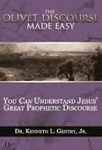
Olivet Discourse Made Easy (by Ken Gentry)
Verse-by-verse analysis of Christ’s teaching on Jerusalem’s destruction in Matt 24. Show the great tribulation is past, having occurred in AD 70.
See more study materials at: www.KennethGentry.com
Furthermore, this grant of kingly authority was prophesied in Psalm 2:6-7:
I will surely tell of the decree of the Lord;
He said to Me, ‘Thou art My Son,
Today I have begotten Thee.
Ask of Me, and I will surely give the nations as Thine inheritance,
And the very ends of the earth as Thy possession.’
In Acts this passage from Psalm 2 is clearly applied to the resurrection of Christ. Acts 13:33-34 reads: “God has fulfilled this promise to our children in that He raised up Jesus, as it is also written in the second Psalm, ‘Thou art My Son; Today I have begotten Thee.’ And as for the fact that He raised Him up from the dead, no more to return to decay . . . .”
Though not referring to Psalm 2, Acts 2:30-31 agrees that the resurrection of Christ was to kingly authority: “And so, because [David] was a prophet, and knew that God had sworn to him with an oath to seat one of his descendants upon his throne, he looked ahead and spoke of the resurrection of the Christ . . . .” Then Peter, making reference to Psalm 110, adds: “For it was not David who ascended into heaven, but he himself says: ‘The Lord said to My Lord, Sit at My right hand, Until I make Thine enemies a footstool for Thy feet'” (Acts 2:34b-35).
Turning back to Matthew 28:18, we should note that Christ’s statement indicates something new has occurred as the result of the completion of His redemptive work at His resurrection from the grave. He has now been given “all authority.” The wondrous significance of this will be demonstrated below.
Christ is our prophet, priest, and king, and His Great Commission exhibits His manifold ministry to His people. Thus, in this and the following chapter, we will see that He speaks as the Great King, who rules over His vast kingdom, in that He has “all authority in heaven and on earth” (Matt. 28:18b). He is “the King of kings and Lord of lords” (Rev. 19:16). In Chapter Five we will see how the Great Commission is also a prophetic Commission. As the Great Prophet, Christ declares the will of God for all the world, by teaching men “to observe all that I commanded” (Matt. 28:20a). In Chapter Six, the priestly aspect of the Commission will become evident. As the Great High Priest, He secures the worshipful oaths of those over whom it holds sway, in His command to “baptize” the nations (Matt. 28:19b).









September 30, 2016
THE COMMISSION AND SOVEREIGNTY (1)
 PMT 2016-073 by Kenneth L. Gentry, Jr.
PMT 2016-073 by Kenneth L. Gentry, Jr.
The Great Commission is a key foundation stone in the New Testament for postmillennialism. Is not called the “Great” Commission for no reason. It is great in terms of its program (worldwide victory), as well as its Presenter (Jesus Christ). It powerfully presents the sovereign Lord declaring his sovereign mission.
As we approach the Great Commission from a covenantal perspective, we discover that its contextual setting clearly points to its sovereign disposition in a number of ways.
Opening the matter, we must recognize that the books of Scripture were written by real, flesh-and-blood, historical men under the inspiration of the Holy Spirit. Thus the books were given in particular, concrete historical contexts (2 Pet. 1:21). The Scriptures did not fall from heaven as a book of mysteries. Consequently, at least a general understanding of the historical and geographical contexts of any given passage is helpful to its fuller and more accurate apprehension.
In addition to being aware of the historical and geographical contexts of any given passage, it is often helpful to understand something of the literary structure of the particular book of Scripture in which it is found. This is especially true of the Gospels, which represent a new literary genre that is neither biography nor theology. This literary genre is “gospel.” As New Testament theologian Donald B. Guthrie has noted of the Gospels: “Whereas they are historical in form, their purpose was something more than historical. It is not, in fact, an accident that they were called ‘Gospels’ at an early period in Christian history . . . . [T]here were no parallels to the Gospel form which served as a pattern for the earliest writers.”

Greatness of the Great Commission (by Ken Gentry)
An insightful analysis of the full implications of the great commission. Impacts postmillennialism as well as the whole Christian worldview.
See more study materials at: www.KennethGentry.com
The Gospels were written by common men, who organized the material according to a thought-out structure, plan, and purpose (cf. Luke 1:1-4). So something of the literary structure of Matthew will also be helpful in opening to us the sovereignty of the covenantal Great Commission. In this three-part series I will consider the place, time, and literary setting of the Commission. I will begin with:
Sovereignty and It’s Geographical Context
As we turn to the geographical matter, we will note the covenantal significance of both the region and the topography of the place where the Commission was given. The region was in “Galilee”; the topographical setting was on a “mountain.”
Galilee
The Gospels teach us that Christ’s disciples were instructed by Him to go a certain, specified place in Galilee to meet Him after the resurrection. And, of course, the Matthew 28:16 reference is from the very context of the Great Commission.
It is interesting that Christ instructs His disciples to meet him in Galilee. Of course, Christ lived there in His youth, called His disciples in Galilee, and performed much of His ministry there. Yet the fact that He would prearrange a post-resurrection appearance with His disciples in Galilee in order to commission them as He does, is instructive. This change of locale is noteworthy in that they were already in Jerusalem, the heart of Israel in Judea, and were very soon to return there to await the Pentecostal empowerment for their mission. Why were they now instructed to take the trip to Galilee?
Galilee was an area in Israel that contained a mixed Jew and gentile population from the earliest times, having been only inadequately conquered and settled by the Jews during the original conquest of the Promised Land (Jdgs. 1:33). In addition, during the later Assyrian conflict, the Jews of the area were carried off into captivity, leaving many gentiles as the inhabitants of the land (2 Kgs. 15:29). For these reasons, Upper Galilee was known as “Galilee of the gentiles.” Also for these reasons, Galileans were noted for their peculiar mixed accent, and were looked down upon by the Jews in the southern, more “pure” regions.
I Will Be Your God
by T. M. Moore
This book is dedicated to encouraging such an outlook on life. It does so by promoting a better understanding of the nature, meaning, and implications of living in God’s covenant.
For more study materials, go to: KennethGentry.com
Interestingly, Matthew is the only Gospel that mentions Christ’s early command for the disciples to avoid the gentiles in their ministry, refers to Jerusalem as “the holy city,” and records Christ’s being called the “king of the Jews” prior to Pilate’s cross inscription. Yet three times at the end of this Gospel Matthew mentions that Christ was to meet His disciples in Galilee, well away from Jerusalem and well into the area of mixed Jew and gentile inhabitants.
In addition to this information, we should note that just prior to the Great Commission is mentioned the Jewish bribe and the lie regarding the whereabouts of Christ’s body: “They gave a large sum of money to the soldiers, and said, ‘You are to say, “his disciples came by night and stole Him away while we were asleep.’ . . . And they took the money and did as they had been instructed; and this story was widely spread among the Jews, and is to this day.” Upon mention of this cover-up by the Jews in Jerusalem, Christ appears in Galilee to give His commission to “disciple the nations” (Matt. 28:16, 19).
The gospel, as we will see, was designed to promote Christ’s sovereignty over the entire world of men, not just the Jews. Thus, even the place of its giving anticipates this, for “in light of [Matt. 4:15ff] it is likely that Galilee here represents all peoples in vs. 19.”
The Mountain
That the disciples went “to the mountain which Jesus had designated” seems also to be for some particular purpose. Christ’s employment of mountains for instructional effect is familiar enough. For instance, the Sermon on the Mount, the Olivet Discourse, and the ascension were from a mountain — the Mount of Olives.
Mountains are significant in Scripture as symbols of sovereignty, majesty, exaltation, and power. As such, they often stand for kingdoms, as several of the verses in the preceding note suggest. It was on a mountain that Christ commissioned His disciples to take the gospel to “the nations.” The majestic effect of this commissioning from a mountain will be dealt with in detail later in Chapter 4. There I will focus on the implications of the hierarchical authority of the commission. At this point, I merely point out the appropriateness of the majestic commissioning of the disciples from a mountain for symbolizing His sovereign transcendence in this covenantal transaction.
The idea is captured well by Lenski: “On mountain heights heaven and earth, as it were, meet, and here the glorified Savior spoke of his power in heaven and on earth. With the vast expanse of the sky above him and the great panorama of the earth spread beneath him, Jesus stands in his exaltation and his glory — a striking vision, indeed.” This is why the disciples “worshiped” Him there (Matt. 28:17a).
Conclusion
As we consider the implications of divine sovereignty in the Great Commission we can learn much simply from its geographical setting. But there is more. In the next article I will consider divine sovereignty exhibited in its temporal context.









Kenneth L. Gentry Jr.'s Blog
- Kenneth L. Gentry Jr.'s profile
- 85 followers



